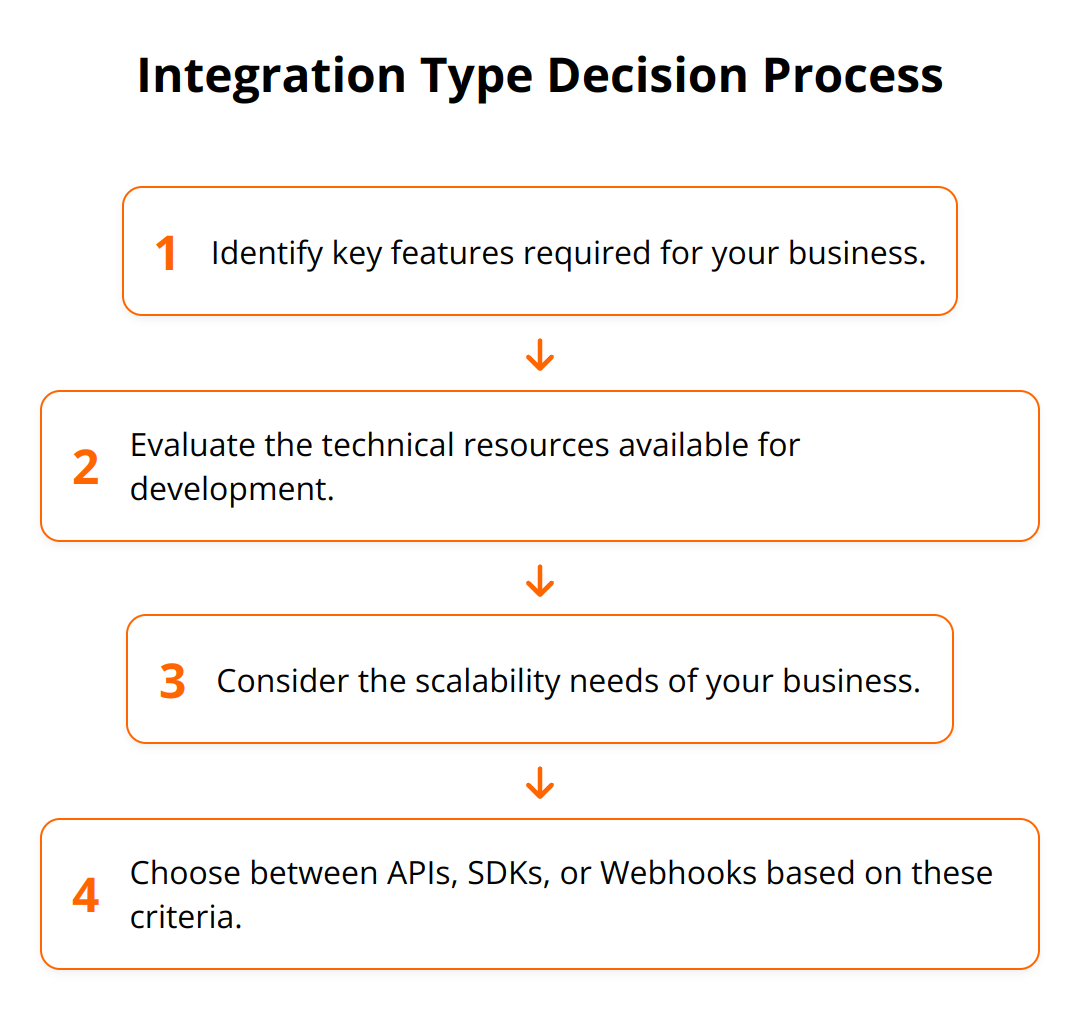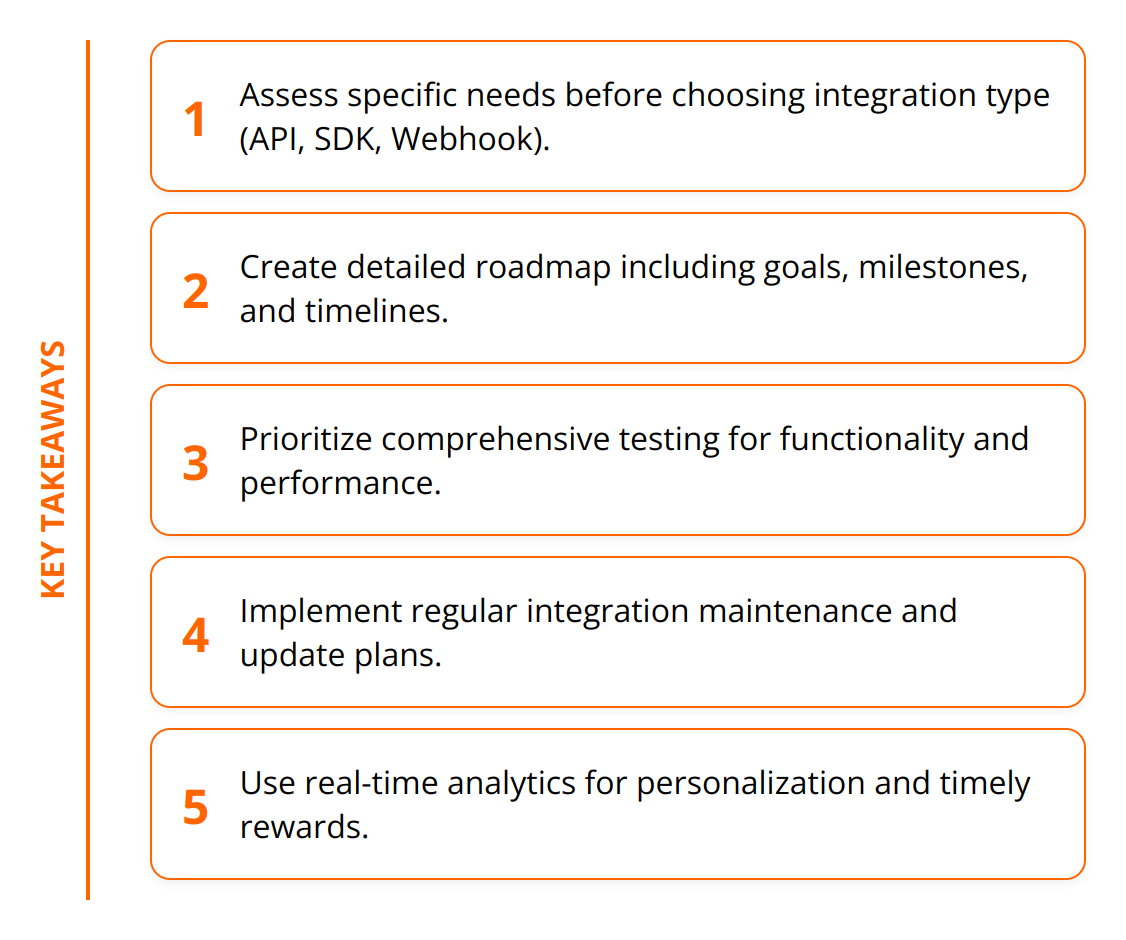
We at Reward the World understand the significance of integrating reward platforms into your business. Seamless integration can significantly elevate user experiences, making it a pivotal aspect for success. This blog post: Reward Platform Integrations: Practical Tips aims to provide practical tips for navigating the intricacies of API, SDK, and Webhook integrations. It’s about ensuring these technologies work for you, enhancing engagement and satisfaction among your users.
Selecting the Right Integration Type
When it comes to integrating reward platforms into your business, understanding the distinct capabilities of APIs, SDKs, and Webhooks is key to fostering an enhanced user experience. Each integration type offers its unique advantages and potential limitations. Here, we’ll explore these differences to help you identify the most fitting integration for your business needs.
APIs (Application Programming Interfaces) provide a robust way to connect and communicate between different software applications. They allow your business to seamlessly integrate reward platform functionalities directly into your existing systems or apps. APIs are highly flexible, making them an excellent choice for businesses looking to offer a wide range of features or those needing to scale operations efficiently. However, they may require more development effort compared to other integration types, especially for complex customizations.
SDKs (Software Development Kits) are a set of tools, guidelines, and programs provided by the platform to simplify the integration process. SDKs are particularly advantageous for mobile app developers as they offer ready-made blocks of code to add specific functions to your app, such as reward redemption or tracking user engagement. They significantly reduce development time and ensure that the integration adheres to best practices. The downside might be a slightly reduced flexibility in customization compared to APIs.
Webhooks, on the other hand, offer real-time data transfer between applications. They push notifications to other websites or applications about events happening in real-time, such as when a user redeems a reward. Webhooks are great for creating dynamic and responsive applications that rely on immediate data updates. However, they might not be suitable for all business needs, particularly if your application doesn’t require real-time updates or the management of outbound data pushes is too resource-intensive.

Identifying the Best Fit for Your Business
The decision on which integration to use should not be taken lightly. Consider the following factors:
- Specific Business Needs: Define what functionalities you want to integrate. For API and SDK integrations, consider the range of features and the level of customization you need. For Webhooks, assess whether real-time updates are vital for your application.
- Technical Resources Available: APIs and SDKs might require a significant amount of development work. Ensure you have the right technical team in place. For simpler integrations that provide real-time updates, Webhooks could be a more straightforward choice.
- Scalability: If you anticipate your business growing rapidly, APIs may offer more flexibility to scale up your offerings without extensive additional development.
By carefully evaluating these aspects, you can make an informed decision on the integration type that best aligns with your business goals and user needs. Embracing the right integration can not only elevate the user experience but also streamline your operations, making it a pivotal decision in your business strategy.
For further insight on designing effective customer rewards, consider exploring best practices in e-commerce incentive programs and customizable rewards platforms, which can provide additional context and guidance in aligning your reward system with your business model.
Streamlining Reward Integration
Ensuring a smooth integration of reward platforms into your business operations is crucial for maintaining efficiency and user satisfaction. To achieve this, meticulous planning, rigorous testing, and diligent maintenance are essential. These practices are not just recommendations; they’re necessities for businesses aiming to leverage reward integrations effectively.
Crafting a Roadmap
Embarking on reward platform integration without a clear plan is akin to navigating without a compass. You must identify your end goals, understand your audience’s needs, and recognize the capabilities and limitations of your current systems. A detailed roadmap that outlines each step of the integration process, including milestones, responsibilities, and timelines, is indispensable. This roadmap serves as an anchor throughout the integration journey, ensuring that every action aligns with your objectives.
Here are quick tips for crafting your roadmap:
- Define specific goals for the integration.
- Identify key stakeholders and assign clear roles.
- Map out the integration process, highlighting critical milestones.
- Set realistic timelines based on your team’s capacity and resources.

Emphasizing Testing
Skipping comprehensive testing is a gamble no business should take. Quality assurance measures, including unit testing, integration testing, and user acceptance testing, are paramount. They not only help identify bugs and incompatibilities early but also ensure that the integration meets user expectations in terms of functionality and performance. Employing automated testing tools can significantly streamline this process, allowing for the execution of repeatable test cases and ensuring consistent results.
For deeper insights into testing strategies, Incentive Program Analytics offers valuable guiding principles.
Prioritizing Maintenance
Integration isn’t a one-and-done deal. The digital environment is ever-evolving, with constant updates to APIs, SDKs, and webhooks. Regular monitoring and maintenance are pivotal to ensure ongoing performance and security. Setting up alerts for system errors or performance anomalies can help you tackle issues proactively. Moreover, keeping abreast of updates from your reward platform provider and planning for necessary adaptations will safeguard your integration against becoming outdated.

Implementing these best practices requires a commitment to excellence and a forward-thinking approach. It’s about leveraging technology to deliver unparalleled user experiences while simultaneously optimizing operational efficiency. The effort invested in planning, testing, and maintenance not only minimizes risks but also maximizes the value derived from your reward platform integration.
Enhancing User Experience Through Integration
Integrating reward platforms effectively does more than streamline business operations; it directly enhances user experience. A well-implemented integration can transform how users interact with your platform, making every action simpler, faster, and more rewarding. Here’s a dive into practical strategies for personalizing reward experiences, simplifying redemption processes, and engaging users with timely incentives to uplift overall experience.
Personalization at Its Core
In today’s digital landscape, personalization is not a plus; it’s expected. Users crave experiences tailored to their preferences and behavior. Implementing advanced analytical tools to analyze user data can help achieve this. By understanding user interactions, purchasing habits, and engagement levels, businesses can offer rewards that genuinely resonate with their audience.
- Actionable insight: Use data analytics to segment users and tailor rewards accordingly.

Streamlining the Redemption Process
A complex redemption process can deter users from engaging with your rewards program. Simplification is key. Implement a one-click redemption feature, ensuring that users can claim their rewards with minimal effort. By reducing barriers, user satisfaction increases, driving further engagement with your platform.
- Pro tip: Incorporate clear, concise instructions and visual cues to guide users through the redemption process.
Timely Incentives Keep Users Engaged
The timing of reward offers can significantly impact user engagement. Leveraging real-time analytics to trigger instant rewards or incentives based on user actions or milestones fosters a dynamic and responsive user experience. This real-time engagement can transform a mundane interaction into an exciting opportunity, encouraging repeat visits and sustained interaction.
- Best practice: Set up automated triggers for rewards based on user achievements or significant dates such as anniversaries or birthdays.

Implementing these strategies requires a thoughtful approach to integration, ensuring that the technologies not only support but enhance these objectives. By personalizing the reward experience, simplifying redemption, and providing timely incentives, businesses can significantly uplift the user experience, leading to higher engagement rates, improved satisfaction, and ultimately, loyalty. For insights on creating engaging reward systems, check out personalized rewards strategies.
These practical steps are crucial for leveraging reward platform integrations to enhance user experiences. By focusing on personalization, simplicity in redemption, and timely incentives, businesses can elevate their reward programs, making them more engaging and effective for users.
Wrapping Up
As we conclude our exploration into reward platform integrations, it’s clear that the journey to an effective reward system is marked by thoughtful planning, detailed execution, and ongoing optimization. From deciding between APIs, SDKs, and Webhooks to the meticulous crafting of a roadmap, each step plays a critical role in enhancing the user experience and boosting engagement.

We underscored the importance of testing for ensuring seamless functionality and emphasized maintenance to keep the system relevant and efficient. By personalizing the user experience, streamlining redemption processes, and offering timely incentives, businesses can foster deeper connections with their users, leading to increased loyalty and engagement.
The journey doesn’t end with integration. The digital landscape is continuously evolving, necessitating constant updates and improvements to your system. Continuous improvement ensures that your reward platform remains competitive, aligns with user expectations, and adapts to technological advancements. Regularly reviewing user feedback, analyzing performance data, and keeping an eye on emerging trends are practices that drive success.
At Reward the World, we understand the profound impact a well-integrated reward platform can have on your business. Our global incentives platform, available in 15 languages and catering to a 250 million-user base, is designed to elevate customer engagement and enhance company performance. With instant reward delivery, GDPR compliance, and robust analytics, we offer a comprehensive solution for companies looking to make a mark.
Remember, the right integration can transform your rewards program from a nice-to-have to a pivotal element of your business strategy. Embrace innovation, focus on the user experience, and commit to continuous enhancement. The effort you invest today will pave the way for unparalleled user satisfaction and business growth tomorrow. We hope you will have found this article: Reward Platform Integrations: Practical Tips, helpful.
